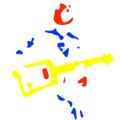Chords underpin modern harmony and so understanding how they are constructed helps nearly every musical decision you make.
Before you start
Here's where it all comes together so make sure you can:
- Find the tonic on every string on your guitar.
- Build a major scale up from that tonic.
I talk about chords a lot in this lesson but don't explain the fingerings. It would just take too long and there are resources elsewhere on the site for both 3 string and 4 string players.
The lesson
Chords and scales can be treated the same when it comes to harmonic theory. The difference is that chords have less notes so the question then is which notes do you pick and which ones do you leave out?
The answer essentially comes back to our study of the harmonic series where we discovered that the first, third and fifth notes of the scale were the strongest overtones in most sounds that we hear. It makes sense then that these notes would sound good when played together. Since a chord is just a bunch of notes played at the same time then it should be no surprise that these three notes together would give us a major chord. Then we learned that, apart from the tonic, we can move these notes around or add other ones to create new chords with different qualities.
It can be helpful to think of chords a stack of intervals piled on top of each other. A major chord for example is a major 3rd with a minor 3rd on top. Another major 3rd on top and you have a major 7th chord but if you put a minor third on top you get a regular 7th chord.
The following table lists a stack of different chord types and describes how they are constructed. You probably won't use most of them but if you can see how they are constructed you'll understand a lot more about how harmonic theory works which will help you're playing down the track. Guaranteed.
| Chord name | Structure | Interval Structure |
| Major | Tonic, major third, perfect 5th (1,3,5) | major 3rd + minor 3rd |
| Minor | Tonic, minor 3rd, perfect fifth (1, flat3, 5) | minor 3rd + major 3rd |
| Major 7th | Tonic, Major 3rd, perfect 5th, major 7th (1, 3, 5, 7) | major chord + major 7th |
| 7th | Tonic ,major 3rd, perfect 5th, flat 7 (1, 3, 5, flat7) | major 3rd + minor 3rd + minor 3rd |
| minor 7th | Tonic, minor 3rd, perfect 5th, flat 7 (1, flat3, 5, flat7) | minor 4rd + major 3rd + minor 3rd |
| 6th | Tonic, major 3rd, perfect 5th, major 6th (1,3,5,6) | major chord + major 2nd |
| minor 6th | Tonic, minor 3rd, perfect 5th, major 6th (1, flat3, 5, 6) | minor chord + minor 2nd |
| diminished | Tonic, minor 3rd, flat 5 (1, flat3, flat5) | minor 3rd + minor 3rd |
| augmented | 7th chord with #5 | major 3rd + major 3rd |
| 9th | 7th chord plus the 2 | 7th chord + major 3rd |
| 11th | 9th chord plus the 4 (9 optional but needs the flat7) | 9th chord + minor 3rd |
| 13th | 11th chord plus the 6 (9 and 11 optional but needs the flat7) | 11th chord + major 3rd |
| altered chord | 7th chord with either the #9, b9, b5, #5 | many combinations |
| add 2 | major chord plus the 2 | major 2nd + major 2nd + minor 3rd |
| sus4 | Tonic, perfect 4th, perfect 5th (1, 4, 5) | perfect 4th + major 2nd |
Take Home
A chord is 3 or more different notes played at the same time. The chord will have a particular sound depending on the function of the notes you pick.
The Lesson video
Again I'm demonstrating a lot of theory in a short time so I've assumed you've nailed everything else before coming here, that you've read the notes above and that you can wrap your fingers around these chords.
There are chord charts for 3 string and 4 string players and all the various courses, workshops and ebooks will get your hands working properly.
You can download the video here.
Learning the fretboard
An arpeggio is simply all of the chord notes played sequentially rather than all together. Arpeggios are particularly useful for 3 string players who in many cases can't play full chords because all three notes simply can't be reached. The first task here is to find as many arpeggios in G as you can.
- Start with the tonic, move up a major third to the 3 and then another minor third to the 5.
- See if you can play all three notes across different strings with minimal hand movement.
- Then add another minor third to play a 7th chord arpeggio.
- Start again but this time make it a minor chord.
- Use the table in the lesson notes above to play as many chord/arpeggio patterns as you can.
